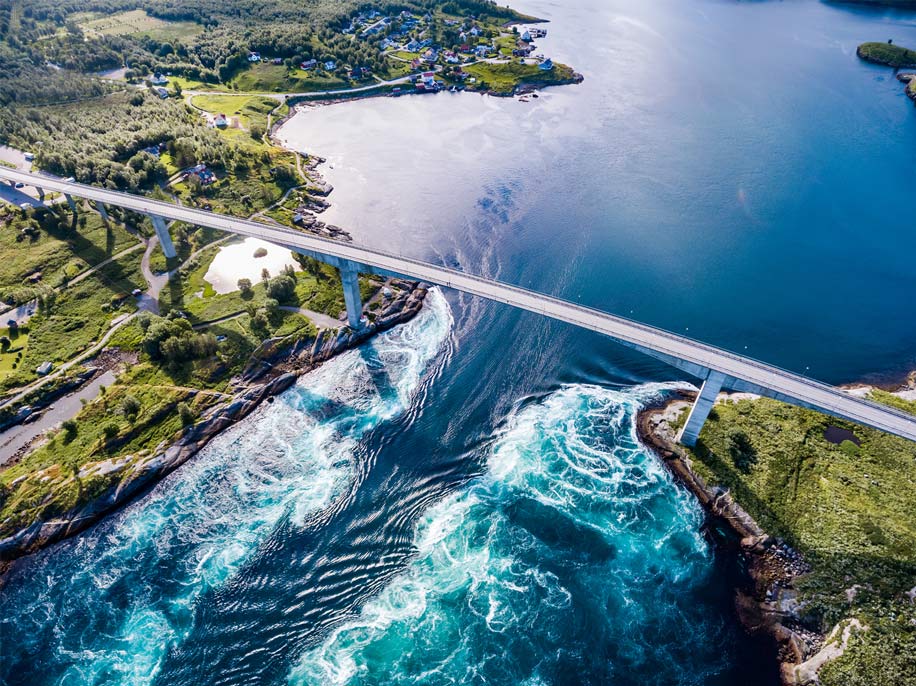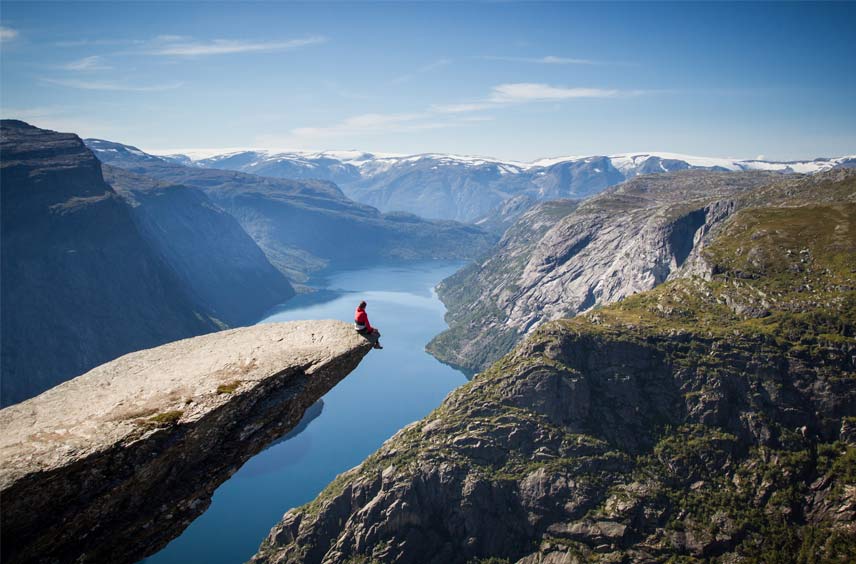By Sofia Haan
Want to explore some of Norway’s most breathtaking sites? In the April issue of Viking, we highlight one of the country’s most incredible natural wonders, the Saltstraumen. Read more about it and add these other unique places to your bucket list.

Whirlpools of the maelstrom of Saltstraumen, Nordland, Norway
Saltstraumen
Just north of the Arctic Circle near Bodø, experience Saltstraumen, the world’s strongest maelstrom (oceanic whirlpools). More than 105,000 billion gallons of water rush through the strait between Saltenfjord and Skjerstadfjord at nearly 25 miles per hour to create 30-foot spinning whirlpools every six hours. Since this whirlpool is a tidal current, Saltstraumen is strongest just after the new and full moon. Experience this incredible phenomenon by land from the bridge Saltstraumbrua or by water in an inflatable boat.
The Seven Sisters Waterfall
This is one of the most photographed waterfalls in Geirangerfjord, where seven separate streams descend about 820 feet into the fjord. Local legend has it that the sisters were all unmarried, and the waterfall on the other side of the fjord has been called “The Suitor” after several unsuccessful attempts to court the sister. This UNESCO World Heritage Site is at its most beautiful from May through July, when the melting snow raises the waterfall and makes the falls naturally more visible.
Trolltunga
For an incredible hiking adventure, hike to the top of Trolltunga, the most spectacular rock formation in Norway! Trolltunga, which translates to Troll Tongue, is a rock that juts out 2,297 feet above the lake Ringedalsvatnet. The nearly 18-mile roundtrip hike through the mountain terrain up to Trolltunga is long, physically demanding and recommended for more experienced hikers, but the journey is worth the amazing views.

Trolltunga in Norway
Jostedalsbreen Glacier
Explore the frozen landscape of Jostedalsbreen, the largest glacier in mainland Europe. Covering almost half of Jostedalsbreen National Park, the glacier separates two of the longest fjords in the world, Sognefjord and Nordfjord. The massive glacier covers 183 square miles and has a maximum thickness of 1,873 feet. Jostedalsbreen is best explored through glacial hikes with the help of an experienced guide and hikers can visit glacier museums in Jostedal and Fjærland.
Preikestolen
Preikestolen (Pulpit Rock) stands 1,982 feet above the Lysefjord and is known internationally as an exciting, nature-based experience. This mountain plateau was likely formed by frost erosion about 10,000 years ago. Nearly 300,000 people visit this rock formation every year to experience the hike up to a spectacular view that looks over the Lysefjord. Conservation efforts have resulted in Pulpit Rock earning a National Hiking Trail status and has been certified as a Sustainable Destination as a part of the Lysefjord.
Kjeragbolten
Located on Kjerag mountain, a 176-cubic-foot boulder is suspended high 3,156 feet above the fjord. The popular destination not only attracts adventurous travelers, but also BASE jumpers who come to the site to jump 3,642 feet off the steep cliffs. The hike to reach Kjeragbolten is about seven miles and take approximately six to 10 hours. Visitors will find the boulder and its panoramic views as the grand prize for completing the challenging hike.
Torghatten Mountain
Torghatten Mountain is unlike any other mountain in Norway—a hole runs all the way through it. Legend has it that a troll’s arrow formed the 524 feet by 66 feet by 115 feet opening, but geologists believe that the tunnel was likely created by ice and water eroding the loose rock sediment throughout the midpoint of the mountain. You can explore this geological wonder by hiking to the top or walking and bicycling around it.
